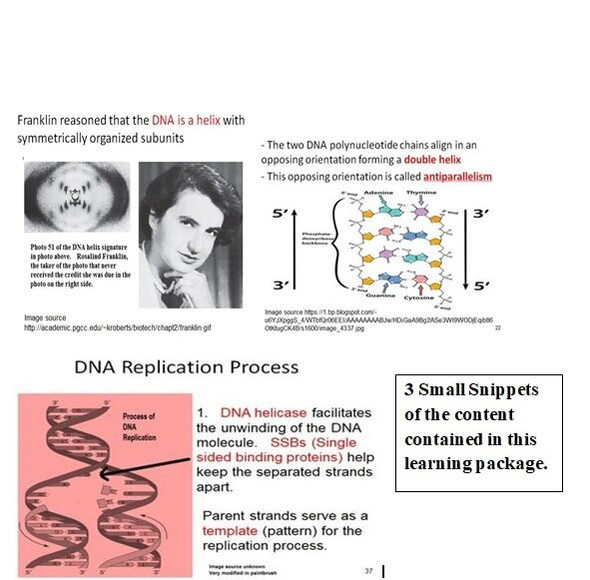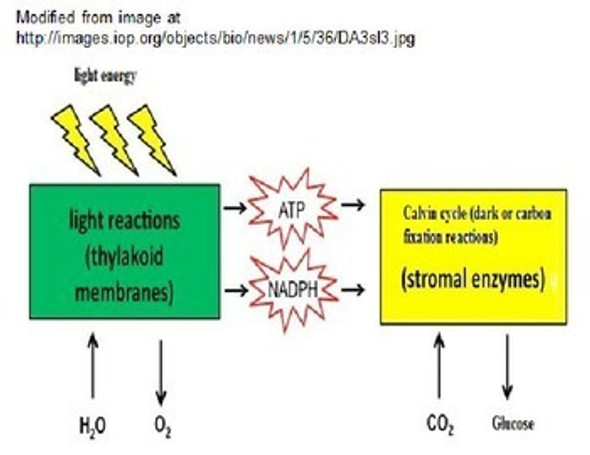Description
This is a series of lesson activities for a unit on Nucleic Acids, Protein Synthesis and Introduction to Biotechnology for introductory biology students. These learning package has been correlated to the NGSS, Common Core and NY Living Environment core curriculum standards. The materials are appropriate for introducing basic information concerning nucleic acids, protein synthesis and some aspects of biotechnology to your students. Specific learning goals addressed by the materials are listed toward the end of this course description.
With the exception of the genetic code sheet, all pdf files are also available as editable word files to allow you to tailor the materials for your course and your students. These documents are well suited for use in distance learning environments.
These activities Introducing the Nucleic Acids (DNA and RNA), Protein Synthesis and Biotechnology are in a zip file (containing 22 individual files and 59 pages on student handouts) which includes the following components::
- 6 page cloze notes handout for students including unit learning goals
- 117 slide PowerPoint to accompany the cloze notes for students
- 6 bell ringers/closures with answers included in PowerPoint
- Marzano student self assessment handout for unit
- DNA Structure and Replication Worksheet with key
- Protein Synthesis Worksheet One with key
- Protein Synthesis Worksheet Two with key
- Biotechnology Worksheet One with key
- Biotechnology Worksheet Two with key
- Biotechnology Worksheet Three with key
- Molecular Genetics and Biotechnology 82 question practice exam with answers
- Universal Genetic Code Chart (in pdf only)
- Curriculum Correlations to the NGSS, Common Core and NY Living Environment Core Curriculum standards
Learning Goals for Molecular Genetics and Biotechnology
Upon the completion of this unit the student will:
1. recognize that DNA (deoxyribonucleic acid) controls cellular activity by influencing the production of enzymes.
2. describe the structure of a nucleotide.
3. describe the structure of the DNA molecule.
4. explain what is meant by complementary base pairing.
5. explain how DNA is able to replicate itself during mitosis and meiosis.
6. correctly define the term template.
7. explain the usefulness of the Watson-Crick model of DNA.
8. define the term polymer and explain why DNA and RNA are polymers.
9. describe the structure of RNA and list three ways it differs in structure from DNA.
10. explain how proteins are synthesized from a DNA template.
11. explain how DNA, RNA, and proteins are able to determine the individuality of an organism.
12. recognize that the work of a cell is carried out by the many different kinds of molecules it assembles (especially its proteins).
13. recognize that proteins are long, folded molecules composed of up to 20 different kinds of amino acids which interact to produce specific protein shapes that determine its function.
14. recognize that enzymes and hormones are proteins.
15. explain why offspring resemble but display differences from their parents.
16. explain why the body cells of an organism can be very different from each other, even though they have the same genetic makeup.
17. explain what is meant by cloning and list some uses of this.
18. describe the process of genetic engineering and list three uses for this procedure.
19. explain what restriction enzymes are and how they are used.
20. describe selective breeding and genetic engineering and lists similarities and differences between each process.
21. recognize that inserting, deleting, or altering DNA segments can alter genes and that this alteration may be passed on to every cell that develops from the altered cell.
22. explain what the genetic mapping is.
23. explain what the human genome project is and some potential advantages and disadvantages of this work.
24. discuss how electrophoresis is used to separate charged molecules such as DNA fragments.
25. explain the role of the electric current, wells, agar, buffer, and restriction enzymes in the process of electrophoresis.
26. explain how karyotyping is used to diagnose Down syndrome.
27. describe the process of amniocentesis and how it is used in providing cells for analysis from a fetus.
NGSS Standards
Students who demonstrate understanding can:
HS-LS3-1. Ask questions to clarify relationships about the role of DNA and chromosomes in coding the instructions for characteristic traits passed from parents to offspring.
HS-LS3-2. Make and defend a claim based on evidence that inheritable genetic variations may result from: (1) new genetic combinations through meiosis, (2) viable errors occurring during replication, and/or (3) mutations caused by environmental factors.
HS-LS3-3. Apply concepts of statistics and probability to explain the variation and distribution of expressed traits in a population.
Common Core State Standards Connections:
ELA/Literacy
RST.11-12.1 Cite specific textual evidence to support analysis of science and technical texts, attending to important distinctions the author makes and to any gaps or inconsistencies in the account.
RST.11-12.9 Synthesize information from a range of sources (e.g., texts, experiments, simulations) into a coherent understanding of a process, phenomenon, or concept, resolving conflicting information when possible.
WHST.9-12.1 Write arguments focused on discipline-specific content.
Mathematics
MP.2 Reason abstractly and quantitatively.
NY Living Environment Core Curriculum
Performance Indicator 2.1
Explain how the structure and replication of genetic material result in offspring that resemble their parents.
Major Understandings
2.1a Genes are inherited, but their expression can be modified by interactions with the environment.
2.1b Every organism requires a set of coded instructions for specifying its traits. For offspring to resemble their parents, there must be a reliable way to transfer information from one generation to the next. Heredity is the passage of these instructions from one generation to another.
2.1c Hereditary information is contained in genes, located in the chromosomes of each cell. An inherited trait of an individual can be determined by one or by many genes, and a single gene can influence more than one trait. A human cell contains many thousands of different genes in its nucleus.
2.1d In asexually reproducing organisms, all the genes come from a single parent. Asexually produced offspring are normally genetically identical to the parent.
2.1e In sexually reproducing organisms, the new individual receives half of the genetic information from its mother (via the egg) and half fromits father (via the sperm). Sexually produced offspring often resemble, but are not identical to, either of their parents.
2.1f In all organisms, the coded instructions for specifying the characteristics of the organism are carried in DNA, a large molecule formed from subunits arranged in a sequence with bases of four kinds (represented by A, G, C, and T). The chemical and structural properties of DNA are the basis for how the genetic information that underlies heredity is both encoded in genes (as a string of molecular ÒbasesÓ) and replicated by means of a template.
2.1g Cells store and use coded information. The genetic information stored in DNA is used to direct the synthesis of the thousands of proteins that each cell requires.
2.1h Genes are segments of DNA molecules. Any alteration of the DNA sequence is a mutation. Usually, an altered gene will be passed on to every cell that develops from it.
2.1i The work of the cell is carried out by the many different types of molecules it assembles, mostly proteins. Protein molecules are long, usually folded chains made from 20 different kinds of amino acids in a specific sequence. This sequence influences the shape of the protein. The shape of the protein, in turn, determines its function.
2.1j Offspring resemble their parents because they inherit similar genes that code for the production of proteins that form similar structures and perform similar functions.
2.1k The many body cells in an individual can be very different from one another, even though they are all descended from a single cell and thus have essentially identical genetic instructions. This is because different parts of these instructions are used in different types of cells, and are influenced by the cell's environment and past history.
Performance Indicator 2.2
Explain how the technology of genetic engineering allows humans to alter genetic makeup of organisms.
Major Understandings
2.2a For thousands of years new varieties of cultivated plants and domestic animals have resulted from selective breeding for particular traits.
2.2b In recent years new varieties of farm plants and animals have been engineered by manipulating their genetic instructions to produce new characteristics.
2.2c Different enzymes can be used to cut, copy, and move segments of DNA. Characteristics produced by the segments of DNA may be expressed when these segments are inserted into new organisms, such as bacteria.
2.2d Inserting, deleting, or substituting DNA segments can alter genes. An altered gene may be passed on to every cell that develops from it.
2.2e Knowledge of genetics is making possible new fields of health care; for example, finding genes which may have mutations that can cause disease will aid in the development of preventive measures to fight disease. Substances, such as hormones and enzymes, from genetically engineered organisms may reduce the cost and side effects of replacing missing body chemicals.
Appendix A—Lab Skills
¥ Makes observations of biological processes
¥ Uses chromatography and/or electrophoresis to separate molecules
¥ Organizes data through the use of data tables and graphs
¥ Analyzes results from observations/expressed data
¥ Formulates an appropriate conclusion or generalization from the results of an experiment
¥ Recognizes assumptions and limitations of the experiment
Bundle and Save!
Many more biology materials are available from Monday's Rescue. The Biology/Life Science Course contains 22 units which can be used to develop a full year course. A purchase of the Biology/Life Science Course provides significant savings of over 70% compared to purchasing each of the 22 units individually. This course is available for $24.99. It contains over 900 pages of learning materials and 1500 plus PowerPoint slides.
This year long course contains the following units:
- Life Processes and Introduction to Classification Learning Activities
- Cell Structure and Function Lesson Activities
- Membrane and Membrane Processes Learning Activities
- Introduction to Biochemistry and Enzymes Lesson Activities
- Human Nutrition Learning Activities
- Human Circulation Learning Activities
- Immunity Lesson and Lab Activities
- Human Respiration Learning Activities
- Introduction to Cell Respiration Learning Activities
- Introduction to Human Excretion and Human Locomotion Learning Activities
- Nervous and Endocrine Systems Lesson Activities
- Introduction to Mitosis and Asexual Reproduction Lesson Activities
- Introduction to Meiosis Lesson Activities
- Reproduction and Development Lesson Activities
- Plant Systems and Adaptations Lesson Activities
- Photosynthesis Learning Activities
- Plant Reproduction and Development Lesson Activities
- Classical Genetics Learning Activities (Mendelian and Beyond Mendel)
- Introduction to DNA, RNA, Protein Synthesis and Biotechnology Lesson Activities
- Introduction to Evolution Lesson Activities
- Ecology Lesson Activities
- Human Ecology Learning Activities
- Complete NY State Living Environment Regents Review Packets with Answers
View the contents of the whole year course in more detail at Biology/Life Sciences Complete Course
Terms of Use
Purchase of the product is for classroom use by the purchaser only. It is a violation for individuals, schools, and districts to redistribute or sell this item on the Internet or to other individuals. I do encourage you to use and edit these documents to suit your needs with your own students in distance learning environments.
This work is licensed under a Creative Commons Attribution-NonCommercial-ShareAlike 4.0 International License.
















